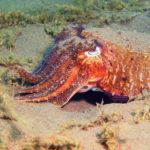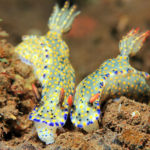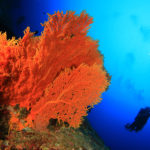Mention diving in Bali and most people will think of mantas and molas in the east and the USAT Liberty shipwreck near Tulamben in the northeast. But there is a whole lot more to discover around the far northwest corner of the island. Off-the-beaten track Bali features a marine park and exciting macro dives, as well as emerging as a new technical diving hotspot. Here, we're taking a closer look at the best secret dive sites in Bali.
The village of Pemuteran in the island's northwest has long been home to a couple dozen dive schools, and its combination of stunning coral reefs and world-class macro diving has kept divers coming back for return visits.
Pemuteran Bay and beyond
Despite offering diving that's suitable for everyone from beginners to committed photographers, the area has remained a rather well-kept secret among divers and non-diving visitors. British expat Paul Turley came here 20 years ago to work as a diving instructor and now owns Sea Rovers Dive Center in Pemuteran. He believes the distance from the airport in Denpasar might have something to do with the region's slower development. "Pemuteran is quite literally a couple of hours off the beaten track of the eastern side of Bali," he says. "And while getting here might take a little longer, the journey itself is worth it, crossing some of Bali's most scenic areas."
Once in Pemuteran, divers and snorkelers can explore from the shore, with reefs starting directly off the beach. This is especially popular for photographers and night dives as well as initial training dives for beginner courses. Pemuteran Jetty, for example, is home to schooling reef fish taking shelter underneath the structure. The sandy areas nearby are a great place for spotting different kinds of pipefish and seahorses as well.
On dusk dives, lucky divers can watch mandarinfish mate. These small, colorful fish hide among hard corals during the day and become more active as the sun sets, peeping out of their hiding spots to look for a mate. Watching them requires patience, good buoyancy control and a bit of luck, but as the dive sites are shallow, it's easy to enjoy long dives often in excess of an hour.
Those more interested in classic reef dives needn't travel far from shore. "Our reef dive sites are within 5 to 10 minutes' boat ride off the beach," says Turley. "They're easily reached and it means that we can come back to shore for our surface interval, enjoying a coffee without bobbing on the sea."
Most of the dives start from a mooring buoy, making donning equipment easy. Descending along a buoy line, divers meet the reefs anywhere from 16 to 33 feet (5 to 10 m) and then follow the slope and current to their target depth. Divers will often see schooling trevallies and mackerel on the way down and the reef walls themselves feature large gorgonian fans with colors encompassing all shades of red, yellow and orange.
One of the local guides' favorite sites is Close Encounters, and it's aptly named: toward the top of the reef, baby reef sharks often shelter under a particularly large table coral. Divers heading for greater depths have a good chance of spotting hunting bluefin trevallies and grown sharks. "Whilst it's not exactly common for the area, we've seen whale sharks here and even the odd mola mola," adds Turley.
Menjangan island marine reserve
About a 30-minute boat ride from Pemuteran lies Menjangan, a small, uninhabited island off the Balinese coast that is part of the West Bali National Park. The island itself has a large deer population and spotting them is a great way to pass the surface interval between two dives. Diving and snorkeling here are equally rewarding. The fringing reef around the island eventually drops sharply, allowing divers to descend along vertical walls covered in hard and soft coral and surrounded by schooling reef fish. Snorkelers simply watch the spectacle from above.
Some of the sites here also have dramatic overhangs, giving divers an idea of what diving a cave might be like without venturing into a true overhead environment. Menjangan is also a great place for those who enjoy drift diving and simply gliding past a scenic wall without too much effort. Eel Garden on the western tip of the island is the area's perfect drift dive.



Perfect muck diving
A little further afield from the main diving and snorkeling areas of Pemuteran and Menjangan, northwest Bali has some excellent muck diving with sites on a par with macro paradises like Lembeh Strait.
One of those is in the unlikely town of Gilimanuk, better known for its harbor and ferry crossings to Java. Virtually around the corner from the hustle and bustle here lies Secret Bay, a shore dive that should be on any macro photographer's bucket list. Volcanic black and white sand mix on this site, making it a perfect spot to find nudibranchs and rare shrimp, as well as mimic and wonderpus octopus.
Further along the coast towards the north-center coast of Bali lies Puri Jati, another macro hotspot. This site offers a sandy bottom as well as some soft coral and has garnered a reputation for spotting Ambon and hairy scorpionfish as well as blue-ringed octopus.
Technical exploration
Technical diving in Bali has largely focused on the Amed/Tulamben area. This only changed very recently, with tech divers currently exploring more sites nearly on a weekly basis. The deeper reefs mean that tech divers have spotted mola-molas, enjoyed longer shark interactions and seen huge examples of healthy gorgonian fans. Tech diving in Bali's northwest will only get more popular, so stay tuned.
With its combination of muck and reef diving as well as the benefit of getting away from the Bali holiday crowds, the northwest has much to offer. Consequently, it's well worth planning to spend a few days or a week in the area. Once you've had your fill of Bali's best secret dive sites, visit nearby temples or hike in the national park. You'll never run out of activities in this as-yet quiet Balinese dive spot.
The post Secret Dive Sites in Bali appeared first on Scuba Diver Life.
from Scuba Diver Life https://ift.tt/2PFx12P
No comments:
Post a Comment